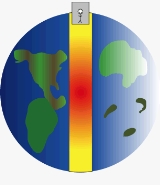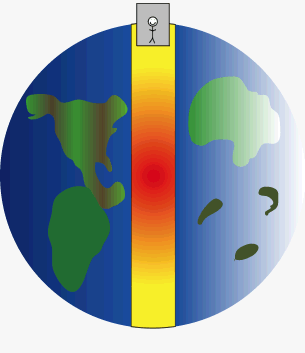
Gravity train
Encyclopedia

Transport
Transport or transportation is the movement of people, cattle, animals and goods from one location to another. Modes of transport include air, rail, road, water, cable, pipeline, and space. The field can be divided into infrastructure, vehicles, and operations...
ation intended to go between two points on the surface of a sphere
Sphere
A sphere is a perfectly round geometrical object in three-dimensional space, such as the shape of a round ball. Like a circle in two dimensions, a perfect sphere is completely symmetrical around its center, with all points on the surface lying the same distance r from the center point...
, following a straight tunnel
Tunnel
A tunnel is an underground passageway, completely enclosed except for openings for egress, commonly at each end.A tunnel may be for foot or vehicular road traffic, for rail traffic, or for a canal. Some tunnels are aqueducts to supply water for consumption or for hydroelectric stations or are sewers...
that goes directly from one point to the other through the interior of the sphere.
In a large body such as a planet
Planet
A planet is a celestial body orbiting a star or stellar remnant that is massive enough to be rounded by its own gravity, is not massive enough to cause thermonuclear fusion, and has cleared its neighbouring region of planetesimals.The term planet is ancient, with ties to history, science,...
, this train could be left to accelerate
Acceleration
In physics, acceleration is the rate of change of velocity with time. In one dimension, acceleration is the rate at which something speeds up or slows down. However, since velocity is a vector, acceleration describes the rate of change of both the magnitude and the direction of velocity. ...
using just the force of gravity, since, during the first half of the trip (from the point of departure until the middle), the downwards pull towards the center of gravity would pull it towards the destination. During the second half of the trip, the acceleration would be in the opposite direction relative to the trajectory, but (ignoring the effects of friction
Friction
Friction is the force resisting the relative motion of solid surfaces, fluid layers, and/or material elements sliding against each other. There are several types of friction:...
) the speed acquired before would be enough to cancel this deceleration exactly (so that the train would reach its destination with speed equal to zero).
Objections
In reality, there are two reasons gravity trains do not exist. First, the transit shown in the illustration would pierce the Earth's mantleMantle (geology)
The mantle is a part of a terrestrial planet or other rocky body large enough to have differentiation by density. The interior of the Earth, similar to the other terrestrial planets, is chemically divided into layers. The mantle is a highly viscous layer between the crust and the outer core....
and traverse a region where rock is more fluid than solid. No materials are known that would withstand the tremendous heat and pressure in the inner core
Inner core
The inner core of the Earth, its innermost hottest part as detected by seismological studies, is a primarily solid ball about in radius, or about 70% that of the Moon...
. Temperature is estimated as 5,700 K (5,430 °C; 9,800 °F), and pressure as about 330 to 360 gigapascals (3,300,000 to 3,600,000 atm). Secondly, friction losses would be significant. Rolling friction losses could be reduced by using a magnetically levitated train. However, unless all air is evacuated from the tunnel, friction losses due to air resistance
Drag (physics)
In fluid dynamics, drag refers to forces which act on a solid object in the direction of the relative fluid flow velocity...
would rise with the square of the velocity. Evacuating the atmosphere to make it a vactrain
Vactrain
A vactrain is a proposed, as-yet-unbuilt design for future high-speed railroad transportation. This would entail building maglev lines through evacuated or partly evacuated tubes or tunnels...
and eliminate drag but would require additional power. Such objections would not apply for solid planets and moons that do not have an atmosphere.
A gravity train can be seen as an extreme version of a roller coaster
Roller coaster
The roller coaster is a popular amusement ride developed for amusement parks and modern theme parks. LaMarcus Adna Thompson patented the first coasters on January 20, 1885...
, with only a downward slope followed by an upward slope. In more technical terms, it is a linear oscillator.
Origin of the concept
In the 17th century, British scientist Robert HookeRobert Hooke
Robert Hooke FRS was an English natural philosopher, architect and polymath.His adult life comprised three distinct periods: as a scientific inquirer lacking money; achieving great wealth and standing through his reputation for hard work and scrupulous honesty following the great fire of 1666, but...
presented the idea of an object accelerating inside a planet in a letter to Isaac Newton
Isaac Newton
Sir Isaac Newton PRS was an English physicist, mathematician, astronomer, natural philosopher, alchemist, and theologian, who has been "considered by many to be the greatest and most influential scientist who ever lived."...
. A gravity train project was seriously presented to the Paris Academy of Sciences in the 19th century. The same idea was proposed, without calculation, by Lewis Carroll
Lewis Carroll
Charles Lutwidge Dodgson , better known by the pseudonym Lewis Carroll , was an English author, mathematician, logician, Anglican deacon and photographer. His most famous writings are Alice's Adventures in Wonderland and its sequel Through the Looking-Glass, as well as the poems "The Hunting of the...
in 1893 in Sylvie and Bruno Concluded. The idea was rediscovered in the 1960s when physicist Paul Cooper published a paper in the American Journal of Physics
American Journal of Physics
The American Journal of Physics is a monthly, peer-reviewed scientific journal published by the American Association of Physics Teachers and the American Institute of Physics. The editor is Jan Tobochnik of Kalamazoo College.-Aims and scope:...
suggesting that gravity trains be considered for a future transportation project.
Mathematical considerations
The gravity train has several curious properties.- All straight-line gravity trains on a given planet take exactly the same amount of time to complete a journey (that is, no matter where on the surface the two endpoints of its trajectory are located). For EarthEarthEarth is the third planet from the Sun, and the densest and fifth-largest of the eight planets in the Solar System. It is also the largest of the Solar System's four terrestrial planets...
, this time would equal 2530.30 seconds (nearly 42.2 minutes) if it were a perfect sphere. - The time of a trip depends only on the densityDensityThe mass density or density of a material is defined as its mass per unit volume. The symbol most often used for density is ρ . In some cases , density is also defined as its weight per unit volume; although, this quantity is more properly called specific weight...
of the planet and the gravitational constantGravitational constantThe gravitational constant, denoted G, is an empirical physical constant involved in the calculation of the gravitational attraction between objects with mass. It appears in Newton's law of universal gravitation and in Einstein's theory of general relativity. It is also known as the universal...
. - The maximum speed is reached at the middle point of the trajectory. For a train that goes directly through the center of the Earth, this maximum speed is about 7,900 metres per secondMetre per secondMetre per second is an SI derived unit of both speed and velocity , defined by distance in metres divided by time in seconds....
(28440 km/h). - The derivation assumes that the mass is distributed homogeneously throughout the earth.
- The shortest time tunnel through a homogeneous earth is a HypocycloidHypocycloidIn geometry, a hypocycloid is a special plane curve generated by the trace of a fixed point on a small circle that rolls within a larger circle...
.
External links
- A Java simulation of this motion; includes tunnels that do not pass through the center of the earth. Also shows a satellite with same period.
- The Gravity Express
- To Everywhere in 42 Minutes
- The fictitious Alameda Weehawken Burrito Tunnel is a gravity train.

